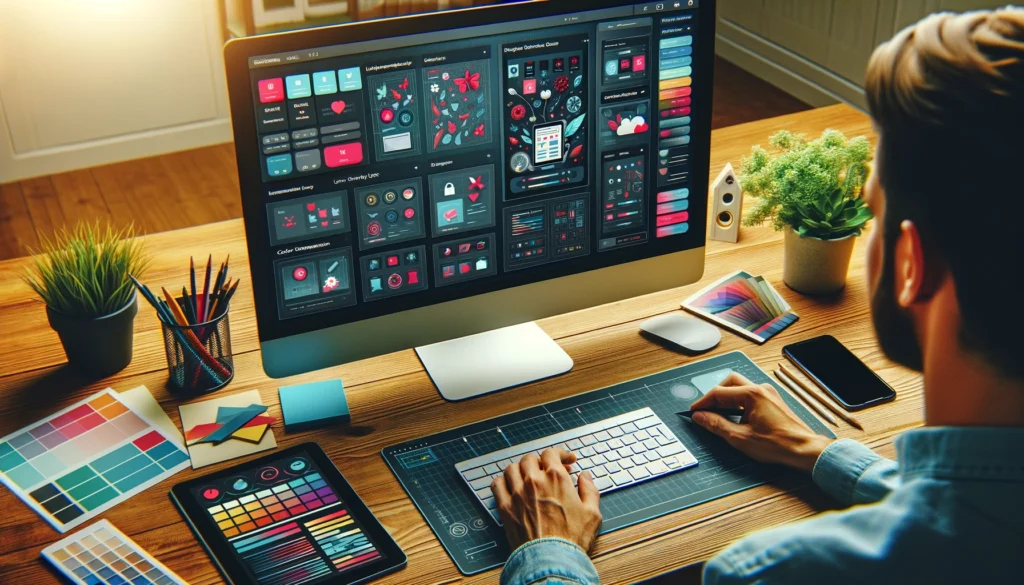In the dynamic field of user experience (UX) design, every product stands as a testament to creativity, strategy, and technique. From mobile applications to web platforms, the development of a product in UX follows a meticulously planned path, ensuring that each solution not only addresses a specific problem but also delivers an unforgettable user experience. This creative journey comprises several critical stages: brainstorming, definition, design, testing, and launch. Each of these phases plays a vital role in the birth of innovative market-defining products.
Brainstorming: Imagining the Future

Brainstorming is the playground of imagination, where everything begins. In this stage, UX design teams dive into brainstorming sessions, exploring every possible solution to an identified problem. This process is fundamentally collaborative, involving designers, developers, marketing specialists, and often, end-users. The goal is to generate a broad range of ideas, without limitations or judgments, to ensure a spectrum of potential solutions.
It’s crucial, during this phase, to maintain an environment where all ideas are welcomed. Techniques such as mind mapping and storyboarding help visualize problems and solutions, fostering a deeper understanding of the end-user and their needs. Additionally, this stage lays the groundwork for genuine innovation, allowing teams to dream without barriers and visualize what does not yet exist.
Ultimately, brainstorming is not just about generating ideas but also about identifying those with the potential to become viable solutions. It’s a delicate balance between creativity and feasibility, where the most promising ideas are selected for further development and refinement in the next stages of the development cycle.
Definition: Shaping the Vision

Once ideas have been generated, the next step is to define them precisely. This stage transforms abstract ideas into tangible concepts, with clear design objectives and user requirements. Here is where UX teams begin to outline the project scope, setting clear goals and success criteria.
The definition also involves extensive user and market research. UX design teams delve into the behavior, needs, and desires of the end-user, using tools like interviews, surveys, and competitive analysis. This understanding of the user is crucial to ensure that the final product is not only usable but also desirable.
Moreover, defining the product strategy becomes a central focus. Critical decisions about the product’s direction, including its unique value proposition and how it will differentiate in the market, are made. This stage sets the foundation for future design and development, ensuring that the final product aligns with user needs and business objectives.
Design: Crafting the Experience

With a clear vision established, the UX team moves to the design stage, where that vision begins to take shape. Here, concepts become prototypes, and ideas are transformed into interactive interfaces. The design focuses not just on aesthetics but also on functionality, ensuring that the product is intuitive and easy to use.
UX design encompasses a wide range of disciplines, from interaction design to visual design, information architecture, and UX writing. Each aspect of the design is meticulously cared for, with the goal of creating a cohesive and appealing user experience. Low and high-fidelity prototypes are essential tools at this phase, allowing teams to test and refine interfaces before moving into full development.
Continual collaboration remains a pillar in the design stage, with constant iterations based on feedback from users and the team. This phase is iterative by nature, aiming to refine the user experience until the product reaches the ideal balance between form and function.
Testing: Validating the Solution

Before launching to the market, it’s crucial to validate that the product meets the expectations and needs of users. The testing stage focuses on evaluating usability, accessibility, and user satisfaction through a series of meticulous user tests. From usability tests to heuristic evaluations, UX teams gather valuable data on how users interact with the product.
This stage is crucial for identifying any usability issues or barriers that may hinder an optimal user experience. The results of these tests are analyzed and used to make adjustments and improvements to the design. The testing phase is, therefore, an iterative process, where the product is continuously refined until maximum efficiency and user satisfaction are achieved.
Moreover, testing also offers the opportunity to validate design hypotheses and ensure that the final product is not only usable but also engaging and valuable to the end-user. It’s a critical phase that guarantees the product is ready to be positively received by the target market.
Launch: Introducing the Product to the World

The launch marks the end of the product development cycle in UX design, but also the beginning of its life in the market. This stage focuses on the product rollout, from distribution logistics to marketing and promotion strategies. The aim is to ensure a successful introduction of the product to the market, effectively reaching the target audience.
The launch is also a time for reflection for UX teams, where learnings from the development process are gathered and plans for future iterations are made. Products in UX design are never static; their success depends on the ability to adapt and evolve with the changing needs of users and market trends.
Additionally, the launch includes monitoring the product’s performance in the market, collecting feedback and critiques from end-users. This information is invaluable for future iterations of the product, ensuring it continues to meet and exceed user expectations.
Conclusion
The product development cycle in UX design is a complex and multifaceted journey, requiring a mix of creativity, strategy, and technique. Each stage, from brainstorming to launch, is crucial for creating products that not only solve problems but also offer memorable and enriching experiences to users. Through collaboration, iteration, and a user-centered approach, UX design teams continue to innovate and define the future of digital products.
